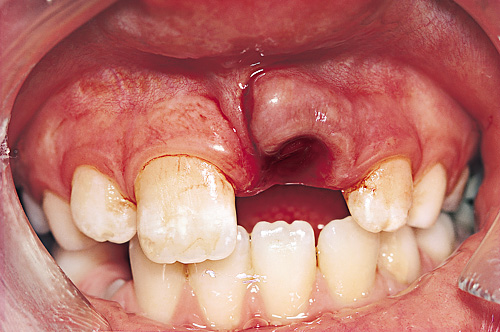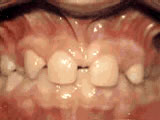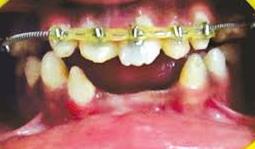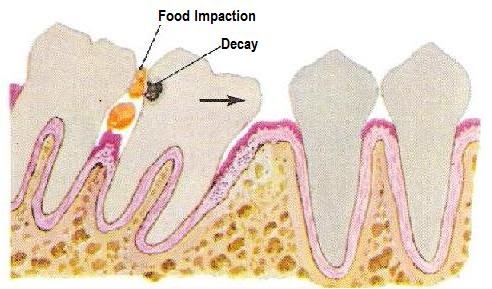Introduction and definition
Missing teeth in the dental arches can affect appearance and occlusion of teeth of the affected child. This is especially so when there is more than one tooth that is missing. The symmetry of the teeth arrangement is most affected and this lead to unpleasing smile.
The reasons for teeth missing in the mouth can either be due to tooth loss or absent from birth. Tooth loss is a process in which one or more teeth become loose and fall out. This process is normal for deciduous teeth (baby teeth), when they are replaced by a person’s adult teeth. Otherwise tooth loss can also be a consequence of injury or disease, such as dental avulsion, tooth decay, and gum disease. On the other hand missing teeth in the arch can also be due their absence since they fail to develop congenitally. Such absence is seen more commonly in the permanent teeth where the primary predecessor teeth exist.
Common Causes of missing teeth are:
- Tooth decay and gum disease.
Tooth decay is caused by increased plaque retention. Bacteria can then invade the plaque and cause dental caries (cavities). If cavities persist untreated for an extended period of time, tooth breakdown occurs and can lead to more severe infection as in Figure 1 (A) or (B). Plaque retention and bacterial presence also affect the gums and bone and their ability to hold the teeth in place. Disease of the gums, known as periodontitis, leads to detachment of the supporting structures from the teeth and their eventual loss. Tooth loss due to tooth decay and gum disease may be prevented by practicing good oral hygiene, and regular check-ups at a dentist’s office.

 Figure 1 (A) : Gum swellingFigure 1 (B) : Facial swelling
Figure 1 (A) : Gum swellingFigure 1 (B) : Facial swelling - Congenital absence
”Hypodontia” is the term used to describe acondition. where several teeth are congenitally absent in the mouth due to their failure in development. Most commonly, the primary (baby) tooth is present but there is no successor (permanent tooth) to replace it. Frequently, this will be apparent when the baby tooth exfoliates, or falls out (usually during adolescence) and replacement by a permanent tooth is not seen. Often however, the baby tooth will remain in place and will function until it fails due to the loss of root support or other dental disease. At this point, it will need to be removed.
Absence of teeth is more frequent in the permanent dentition and girls are more affected by a ratio of 3:2. Most commonly missing teeth are the third molars (wisdom teeth), second premolars and permanent upper second (lateral) incisors.
However, lower central incisors were found to be the most commonly absent teeth in local Malaysian children with 32-49%.
- Trauma
Trauma can cause loss of teeth in a variety of ways. The most common way is during fall and accident when teeth can be “knocked out” from the socket. Frequently however, trauma can affect the teeth in ways that do not manifest until months or years later. Sometimes, after teeth have been traumatized, they can be treated and appear to be doing well until many years later when root resorption becomes apparent. This occurs when the body turns against itself and causes cells to eat away at the root surface, often allowing bone to grow into the defect that has been created.
Tooth loss caused by trauma, can be prevented by wearing mouth guard during sports activities.

 Figure 2 (A) : Knocked-out toothFigure 2 (B) : Displaced-tooth
Figure 2 (A) : Knocked-out toothFigure 2 (B) : Displaced-tooth - Syndromes with underlying medical problems
Missing teeth (tooth agenesis) can occur in an isolated fashion, or as part of a syndrome.Multiple missing teeth and teeth with abnormal shape, may be seen in a number of syndromes including X-linked hypohidrotic ectodermal dysplasia, Ellis van Creveld syndrome and Down Syndrome, Cleft lip and palate.
 Figure 3 (A) : Down SyndromeFigure 3 (B) : Cleft lip and palate
Figure 3 (A) : Down SyndromeFigure 3 (B) : Cleft lip and palate
 Figure 3 (C) : Ectodermal DysplasiaFigure 3 (D) : Abnormal shape
Figure 3 (C) : Ectodermal DysplasiaFigure 3 (D) : Abnormal shape
What can happen when teeth are missing?
Missing teeth can cause more than health problems. It directly affects your self-esteem as tooth loss impinges on your smile and the way your face looks. Here are some other consequences of tooth loss
- Mastication or chewing problems. When teeth are missing, it will compromise the chewing function to the child.This can reduce weight in children and can affect their normal development.
- Generalised spacing in the arch. Missing tooth will create unattractive spaces and aesthetically unpleasant. And also there is going to be potential loss of space for eruption of adult teeth

Figure 4: Generalised spacing in the upper arch - Psychosocial impact of the children such as low self-esteem and lack of confidencewhichcould be detrimental to a person’s well-being. Attractive children are seen to have more positive attitudes and become an example of their peers.
- Speech problems.Loss of teeth would prevent a child to pronounce a correct sound or word
- Increased risk of tooth decayed and gum disease.
When a tooth is lost, food easily gets stuck in the gap and plaque easily forms. Gums may become inflamed, red, swollen and easily bleed. This leads to gum disease and also decay of adjacent teeth.
- Facial asymmetry.
Missing tooth will prevent jaws tobite together properly. It may associate with pain and get worse overtime. After losing a tooth, we tend to favor the side with the most teeth for mastication. The muscle of mastication get overworked and may increased in size. The face will then become asymmetry and joint pain could developat later stage. - Shifting of the teeth.
- When a tooth is missing in the mouth, the bone will usually starts to resorb or melts away. As the bone resorbs, the remaining teeth start to drift into the empty space.
- Over-eruption of the opposing teeth. Teeth maintain the ability to erupt and so if a tooth is lost, the tooth opposite (if not balanced by teeth either side of the space) may grow into the space that has been left.
- Loss of supporting bone.When tooth is absent, there will be lack of stimulation to bone formationand this causes decrease in height and width of the supporting bone over the time.
In order to prevent all those problems, missing teeth must be quickly replaced .Even though there are many options to replace your child’s missing teeth andkeeptheir oral health fit, prevention remains the best resolution.
What can be done if you have missing teeth?
If you have one or more missing teeth, or if you must absolutely extract a tooth, there are many effective options for replacement that are available. You may discuss the different options with your dentist in order to decide which solution is right for you. However you should not remain without replacement of a lost tooth in order to avoid problems mentioned above.
The aim of the treatment is to replace the missing teeth based on the position of the tooth in the arch. The care of children with multiple missing teeth can be complex and ideally requires multidisciplinary input from various dental specialist as well as genetic counseling. The early approach for this condition is related to treatment success. However, definitive treatment of the missing teeth is often performedafter eruption of all permanent teeth.
Radiographic images are essential for recognizing missing teeth in children because the entire dentition must be counted and identified to determine whether a tooth is missing. Accurate prediction of tooth formation, maturation and eruption is necessary for satisfactory treatment planning.
A Pediatric dentist plays an important role in carious prevention and maintenance of the primary teeth in the oral cavity. The baby teeth are required for space maintenance and preservation of supporting bone in the future. The treatment options available for this condition depend on the severity of the missing teeth including:
- Maintenance of primary /baby teeth
- Orthodontic treatment for space management
- Restoration with adhesive bridge or dentures
- Dental implants
Orthodontic treatment
Maintenance of the primary teeth in the arch should be considered if resorption of their roots has not affected their stability. But when extraction of the primary tooth is indicated, orthodontic treatment/appliance should be performed to prevent migration of the adjacent and antagonist teeth. The appliance also helps in redistributing the spaces to allow for adequate space for replacement of dentures or false teeth.
 |
 |
|
Figure 6 (A) : Space management by fixed braces
|
Figure 6 (B) : Teeth replacement by dentures
|
Restorative treatment
Children with multiple missing teeth can be treated by the use of partial dentures. Dentures will need to be replaced as the jaws grow and also mimicks the developing dentition at the child’s age.
Placement of adhesive bridges or fixed dentures would be more stable and provide better results. However ,adhesive bridges and other fixed prosthesis can only be considered when the child has reached 16-18years of age or when growth has stopped on the child.
Early placement of fixed bridges may cause damage to the tooth due to the need to reduce intact tooth structure in the preparation of placement. The risk of pulpal damage is high especially in young children due to the large volume of the pulp chamber.
 |
 |
|
Figure 7 (A) and (B) : Placement of adhesive bridges with replacement of second premolar
|
|
Dental implants
The treatment with dental implants may be the best at a later age until skeletal maturity. It provides stability and excellent aesthetic appearance. When implant is indicated the bone thickness and height must be adequate.
 |
|
Figure 8 : Placement of the implants at the posterior teeth.
|
Bone deficiency may impair the ideal position of the dental implant. Therefore, bone grafting may be required to compensate for this insufficiency. The maintenance of primary teeth favors the normal bone architecture allowing for the placement of implants.
Conclusions
The successful management in missing teeth requires multi-disiplinary approach from various specialities in dentistry. It is important for the parents and their child to know the normal number of teeth their child has and understand the sequence of teeth emergence in the mouth.
Regular dental check-up with Pediatric dentist may prevent the complexity of the treatment
References
- Craddock H.L.(2010). Consequences of tooth loss 2: Dentist Considerations-Restorative problems and implications; Dental update; 37:28-32
- http// educ 220-spring 2010 wikispaces.com
- http// orlandodent.com/bly/what-is-cleft-lip-and-cleft-palate
- Ladda R. Gangadhar SA, Kasalvo, Bhandari AJ (2013). Prosthodontic management of hypohidrotic ectodermal dysplasia with anodontia: A case report in pediatric patient and review of literature. Ann Med Health Sci Res; 3; 277-81
- Laing E., Cunningham S.J., Jones S., Moles D., Gill D. (2010) Psychosocial impact of hypodontia in children. American Journal of Orthodontic Dentofacial Ortopedic; 137:35-41
- Parkin N., Elcock C., Smith R.N., Griffin R.C., Brook A.H.(2009). The aetiology of hypodontia: The prevalence, severity and location of hypodontia within families. Archives of Oral biology; 545: 552-6
- Riekman G.A., Paedo D., Elbradway H.E. (1985). Effects of premature loss of primary maxillary insicors on speech. Journal of Paediatric Dentistry; 7:119-22
- Tunc E.M., bayrack S., Koyuturk A.E.,(2011). Dental Development in children with mild-to-moderate hypodontia. American Journal of Orthodontic Dentofacial Ortopedic; 139: 334-8
- Valle A.L., Lorenzoni F.B., Martins L.M., Valle C.V.M., Henriques F.C., Almeida A.L.P., Pegoraro L.F.(2010). A multidisciplinary approach for the management of hypodontia: case report. Journal of Applied Science; 19: 544-8
- Worsae N., Jensen B.N., Holm B., Holsko J. (2007). Treament of severe hypodontia-oligodontia-an interdisciplinary concept. International Jlournal of Oral and Maxillofacial Surgeons; 36: 473-80
| Last Reviewed | : | 24 August 2015 |
| Writer / Translator | : | Dr. Azalina bt. Osman |
| Accreditor | : | Dr. Laila bt. Abd. Jalil |








